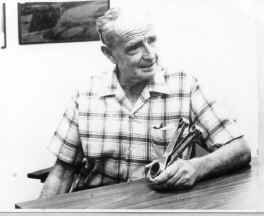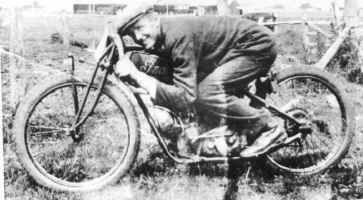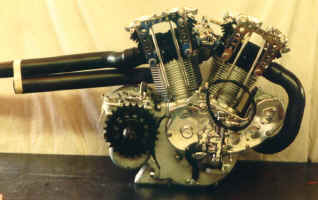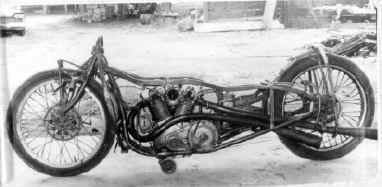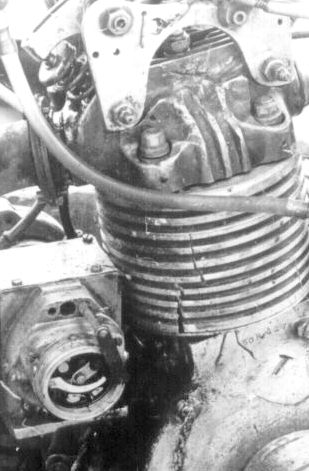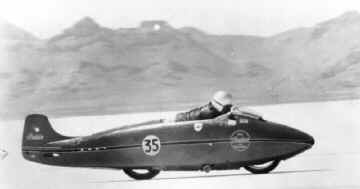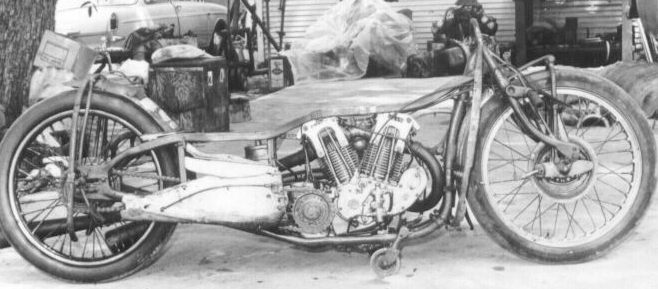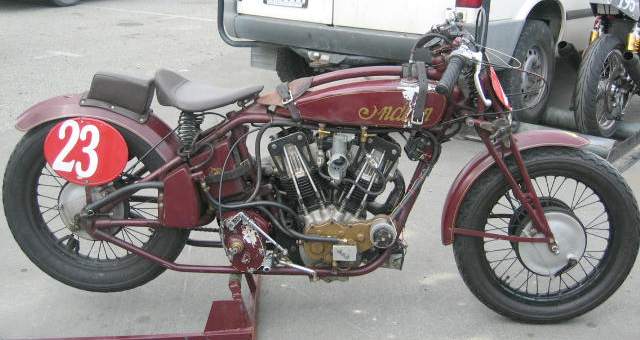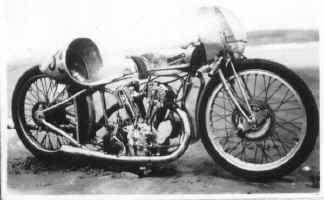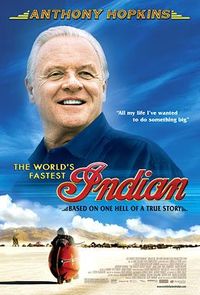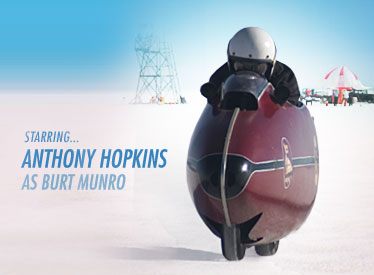|
HERBERT (BURT) JAMES MUNRO 1899 - 1978
|
|||||||||||||||||||||||||||||||||||||||||||||||||||||||||||||||||||||||||||||||||||||||||||||||||||||||||||||||||||||||||||||||||||||||||||||||||||||||||||||
|
HOME | BIOLOGY | FILMS | GEOGRAPHY | HISTORY | INDEX | MUSIC | THE BOAT | SOLAR BOATS |
|||||||||||||||||||||||||||||||||||||||||||||||||||||||||||||||||||||||||||||||||||||||||||||||||||||||||||||||||||||||||||||||||||||||||||||||||||||||||||||
|
Burt Munro was born in 1899 at his parents home in Invercargill. His
twin sister died at birth and Burt, said the doctor, "won't live
till he's two". Fortunately for New Zealand's motorcycle history
the doctor was wrong. In 1915 he bought his first motorcycle, a Douglas, and by 1919 had saved enough to buy a Clyno with sidecar. This cost him £50 new. The sidecar was removed and the Clyno entered in local races. Speed records were set at the Fortrose circuit, near Invercargill, but the Clyno wasn't kept for long when the Indian came on the scene.
Burt
Munro
The Indian Scout came from the board of Charles Franklin, an Indian employee since 1914 and the first trained engineer to be employed by the company. Franklin's background well qualified him for the position. Born in Ireland in 1886 he graduated from the Dublin College of Science in 1908, securing a position in the engineering department of Dublin's municipal government. He became interested in motorcycling, owning several makes of machine and becoming interested in Indian in 1910. He entered local competitions where his ability and success brought him to the notice of the sole British importer of Indians, Billy Wells. He was a member of the Indian team in the 1911 Isle of Man TT, gaining second place behind Oliver Godfrey, and in front of Arthur Moorhouse, both also Indian mounted, in the historic first 1-2-3 by the same make.
studies of advanced motorcycle design and built a prototype, under Indian auspices, in early 1919. Tests were satisfactory and production started in September of that year on the,1920 models, commencing with engine number 5OR001.
In 1920 a 21 year old Burt stood gazing at a brand-new motorcycle in an Invercargill garage. His eyes roved over the neat little V twin engine, the cast alloy primary case, the leaf sprung front fork. His hand lovingly stroked the gleaming red paint and the sparkle of the polished nickel matched that in his eyes. The proprietor was spoken to, a deal was struck, and the young man bought his motorcycle, beginning a partnership which was to last until his death in December 1978. The man was Burt Munro and the bike was an Indian Scout, destined to become the world's fastest Indian.
Burt astride his Indian Scout
He made his own barrels, flywheels, pistons, cams and followers and lubrication system. In their final form he in effect hand-carved his con-rods from a Caterpillar tractor axle, and hardened and tempered them to 143 tons tensile strength. He built a seventeen plate, thousand pound pressure clutch and used a triple chain drive. He experimented with streamlining and, in its final form, the bike was completely enclosed in a streamlined shell. The leaf-sprung fork was dispensed with and what appears to be a girder fork from a 1925 - 1928 Prince substituted.
Indian V Twin Motorcycle Engine
A succession of NZ road and beach records followed. In February 1957 he set a NZ Open Beach record of 131.38 mph, raising this in 1975 to 136 mph at Oreti Beach. In April 1957 he set a 75Occ Road Record at Christchurch at 143.59 mph. In March 1962 he covered the standing 1/4 mile at Invercargill in 12.31 seconds.
Burt, then a grandfather, visited the Bonneville salt flats several times from 1962 onwards. In that year he set a then world record of 178.971 mph with his engine out to 51 cu.in. (85Occ). In 1963 a con-rod broke while he was traveling at an estimated 195mph. In 1966 it was displacing 920cc, when Burt, unhappy with some loss in top speed, completely rebuilt it again.
In 1967, with his engine punched out to 58 cu.in. (950cc) he set a class record of 183.586 mph. To qualify he made a one-way run of 190.07 mph, the fastest ever officially recorded speed on an Indian.
His visits to the salt were not without incident. In issue no. 1 of Motorcycle New Zealand, published in 1973 Burt is quoted as follows:-"At the Salt in 1967 we were going like a bomb. Then she got the wobbles just over half way through the run. To slow her down I sat up. The wind tore my goggles off and the blast forced my eyeballs back into my head - couldn't see a thing. We were so far off the black line that we missed a steel marker stake by inches. I put her down - a few scratches all round but nothing much else". At the time Burt was traveling at close to 206 mph!
Modified Indian Scout Motorcycle
His team at Bonneville consisted of Indian enthusiasts from all over the USA, who came voluntarily to provide help and encouragement. "Picked up a station wagon for $90 in Los Angeles last time," said Burt in the same interview. "It was the headquarters for Team Indian".
Rumor has it that Burt made his barrels from pieces of cast iron gas pipe, which he scrounged from the gas company after they had been dug up for replacement. See the picture on this page for details. He reasoned that, after some years in the ground, they were well seasoned. He then made aluminum slices which he shrunk over the pipe to make fins.
BURT'S OWN WORDS
Well it is a bit hard to cram a brief history and spec of a bike I bought new in 1920 for 140 pounds cash and have been developing since 1926. it has gone 3 ¼ m.p.h. faster each year for 44 years which is about average for some factory bikes over the same period. I have been riding since 1915 and owned a Clyno v-twin in 1919- 1920 which I sold to a blacksmith and then bought the 1920 Scout, engine number 5OR627. I have made 5 heads for it, countless pistons and conrods, carburetors, magneto parts , scores of cams, fork changes, many wheels built as tyres and rims changed. The last one was for the front wheel last July when I changed from 19” to 18” as I cannot get high speed from 19 x 2.75 tires anymore. This I cut the tread off with a knife then smoothed down to the bottom of the non-skid groove.
For the first 22 years after 1926 it was weekends and nights getting ready for hill-climbs, trials and standing ¼ and flying ¼ mile events, and 1 mile dirt sidecar races at Penrith Speedway, NSW, Australia. Between 26 and 29 I had records in hill-climbs, standing ¼ and flying ¼, and petrol consumption runs, one of 116 m.p.g. This covers the start of my tuning efforts and has continued up to the present time. I rode second next to les Weatherby in the world’s first mile TT in Chatswood in North Sydney. The track was cut out of the bush with stumps and roots left, and a high jump out of a deep creek. This is now known as a scramble or motocross.
Indian barrels ala Burt Munro
Then in 1927, solo on Aspendale Speedway, Melbourne, Australia, I jumped off at 90 m.p.h.+ when in a bad speed wobble at the end of straight with one hand on oil pump. We hit a deep gutter and took off on the bend, landed with the bars pulled round a little, and my heavy 29” oversize tire on front just kept the wobble and was heading for the post and rail fence. The 10,000 spectators were told in paper that I was unhurt but I was pretty sick in bed for a week or two with concussion and many bruises. The Saturday before this at Inverloch Beach in Victoria, my flathead Scout won a gold medal at 90.01 mph equal with a 1928 Chicago 61” Harley Davidson ridden by an airforce pilot from point Cook, Victoria, Australia.
From 1929 I returned to New Zealand after four years in Australia when work finally could not be had (this was the Great Depression). I spent the next 10 years as motor cycle traveler. This was finally given up around 1941 when one of my rare (by this time) crashes put me off for 11 months. When I returned to NZ I was invited to join the local motorcycle club and an now a life member and have been for many years. After joining I just lived for beach races, grass track, mile and also ¼ mile, hill climbs, speed trials, trials, road racing, drags and I think the beach was the greatest in 1940. About seven years ago averaged 83.43 m.p.h. in a six mile race which I won. This was on a championship fancied beach course a few miles from Invercargill. This is where I do most of my testing nowadays.
In 1948 I decided to give up work and concentrate on getting a good run out of my old bike as by this time I thought I was getting better at designing parts and would go to the Canterbury Speed Trials held each year north of Christchurch. Well I went there for 22 years, this was a 1,000 mile round trip from home. I broke the NZ records more than once, but was only three times satisfied I had gone as good as I could go at the time, and those three times their timer failed for me. The last time was 10 or 11 years ago and the ACU rep said, never mind, next year we will have cable buried in side of the road.
Burt Munro at Bonneville Salt Falts
Then they could not get it anymore because of increased use of this long straight road known as Tram Road, North Canterbury, NZ. I will try and give you a rough specification of the past and present of engine and cycle. I have and still hold some records in the 37 ci class, under 750 cc class, 55ci class and lastly 61ci class, all with my 1920 flathead Scout. My first major record was the NZ Open Road record established on the Aylesbury straight in 1940 at a mean 120.8m.p.h. This was held for twelve years. The under 750 cc Road record at 143.43 and NZ Open Road record at the same time. Also NZ Beach record in 1957. Although this is still attempted each year it remains unbroken at 132.38 m.p.h.
55 ci AMA world record 1962 at Bonneville, engine was 51ci at this time. 1966 engine 56ci 168.06m.p.h. American 61 ci record 1967 183.6. best run 190.07 qualifying. 1969 record number of runs for a streamliner, 14 in four and a half days. I had magneto and carburetion troubles and finally burned-up pistons when gas tap shut off on last chance of a qualifying run. I have hauled bike or engine to USA eight times in my attempt to get one good run but this has always eluded my greatest efforts.
The last 22 years has been full-time as I could never get enough hours to do things. After finally getting 94 m.p.h. from the flatheads and running on Borneo Aviation Gas I ahd a go at making ohv heads. A foundry told me how to go about making patterns and I finally had them finished after a year of work until the first day it ran. Believe it or not the first runs were slower than my best on the sidevalve but over the years I gradually got it going faster till in 1937 I was getting 110 m.p.h. from it, also breaking conrods. About then a mate and I were returning from a distant beach meeting and another pair of rods had broken, and he said why not write to the Indian factory and get special rods. This got me thinking and I acquired a broken Ford truck axle and carved out two rods in five months. These were in it for 20 years and were standing up to over 140 m.p.h. By 1950 I was getting 150 m.p.h unstreamlined.
I have had many terrific blow-ups, the last two were during this last 11 months. I will describe one I had at Muriwai Beach, Auckland in April 1969. I hauled my Munro Special up there 1130 miles and blew a piston ( I had just made thirteen new ones for 1969), the rod and pin toe up and down, put tram tracks and split both new cylinders, punched large hole in front of case, bent mag armature, broke slip ring and magnets on ML into five pieces. I hauled home and in eight and a half weeks had it running again. Eight more new pistons, two new home made rods, magnets cut form an old Bosch magneto.
Burt Munro's Land Speed Record Indian Motorcycle
The brief history is almost impossible to put together but I should give you a rough idea of some of my best crashes. In 1916, out all day after landing on head. 1921, riding standing on seat of Scout waiting for Uncle Alf to get his King Dick going. I looked round and woke up that evening after a whole days absence from what was going on. In 1927, jumped off on a dirt track Aspendale Speedway at over 90mph. Concussion and bruising from feet to back of neck.
1932, stopped to get a rider going in Western Southland when on my traveling job. I told the guy I would follow him in case it stopped again. We came to a farmhouse at a cross road. A dog ran at him. I caught it on the rebound and came around later concussed and bloody from a deep scalp wound. 1934, crashed Clifton Gorge, struck a wash-out before could pull-up. Came around concussed. 1937, in 20 mile beach race, doing 110 when Hugh Currie, BSA Special, the last rider I had to catch, turned in front of me. I hit the 6” brake and tried to steer behind him as he banked over to turn. My bike climbed up and over his and sailed 120 feet clear of the beach before landing. He was knocked-out and had broken collar bone. My bash-hat was split from crown to rim in two places.
Weeks later he told me what knocked me out and split the hat. The underside of his engine landed square on my head. When he was repairing his bike he found the varnish marks from my hat on the cases. I had all my teeth knocked out and my brother picked up numerous gold filled ones from the sand. This was one of the saddest moments of my life when I found my priceless teeth no more.
1940, running on home built gas producer. Still traveler for some motor cycle firm and running at top speed of 56 m.p.h. on coal. I hit a ridge of wet gravel and ran off to side of road but regained control on fence line. But before I could let go of bar and shut off gas and air lever I hit an 18” deep cutting into a farmhouse, the bike struck the far bank and shot right up into the air and back to the gravel road. My head hit the road, I was unconscious for one and a half hours and came-to blind from dried blood in eyes. I had hemorrhage of brain for a week and concussed, and was of work for 11 months. I had part concuss - ional headaches for about 15 years form this so I gave up the traveling as I did not care to travel by bus or car to sell bikes.
A nicely restored Indian Scout (C 1925)
1959, was in a drag at Teretonga International track when at 110mph the bike got into a sudden fast speed wobble. I jumped off the side and rolled and skidded and bounced 15 feet high they tell me. I finished up in the hospital for seven and a half weeks. When I finished the crash I had bash hat still on, waistband of pants, tennis shoes and pieces of socks. I was only slightly concussed. It was missing flesh, and skin took building up again. One finger was ground half way through the bone but still works but one joint is crook. All the other crashes involved just bones or scars or burns and one arm ripped apart at the shoulder. In five and a half months it grew back but still hurts at rest when I lie on it.
For this year I have made the new cylinders and pistons to the largest bore ever, it is now 3.192 inches x 96mm giving 60.54 ci. For eight years I have carved out new rods, cylinders and pistons and cams, and work full time on either my 1936 Velo or the Indian.
For 10 years I worked 16 hours a day in the shed and was told to slow up a few years ago and now work 7 days and about 70 hours a week. The flywheels I made form 5” axle hammered out under steam hammer. Just finished pistons. I had these eight heat-treated for the first time. Crank in 1928 Scout turned down to ¾” and then sleeved. I made this from oil hardening steel and squeeze on and pull up with standard nuts. I leave the taper with ¾” hole in it to fit drive side flywheel. The rods of course now have bigger eye and smaller rollers. The main shafts right up to about three years ago were standard, about 13/16”; with four sets of caged genuine Indian rollers ¼ x 5/16” running on the shafts.
Well, as speed mounted-up over the years I got visions of them breaking and in 1957 I had a new pin, crank-pin that is, given to me in Springfield on a visit to Indian factory. This I fitted to the timing side with big-end bearings. Then the drive side looked so thin. I looked around and had a spare gearbox mainshaft. So I ground the four outside splines off it and made up two drive shafts form it, then had them re-hardened and ground locally. I bored out the taper in flywheel in my three and a half inch Myford lathe. By the way, I completely made my new cylinder heads in the same lathe. The only change is to cut about one and a quarter off gap in bed for flywheels. This probably weakens it a bit but I still work it every day, and have since it was new 22 years ago. I am on my second set of back gears, worn out about 12 years ago, and my third lead screw is now badly worn.
Indian Scout modification stage
Cams I made by file and saw since 1926 but now have built a cam grinder and make them in pairs as I spent 800 hours in 1963 making the engine into a four cam set-up. After I time them I pin them to the ¼” hole in the standard cam-wheels on Scout. Cam followers are filed from axle steel and I make a fork to take a ¾” x ¼” roller running on needles, and an oiler to keep a good flow from the 1933 Indian oil pump I had given me in 1956. This I modified to pump the oil to big end, and was when I made my steel flywheels.
The 1920 Scout frame and my third streamliner shell are still in USA. The first full shell I built tool me five years to hammer out of sheet aluminum. I could only work at it when I had my bike ready for testing then if it blew-up I would work on the engine until running again, then hammer away at it again, or suddenly think of some new scheme to get more speed. Of course these brainwaves often made it slower or just more blown parts. By the way, I have read of E Fernihough’s death and perhaps I can offer a reason for him running off the road that day. I have several times had similar experiences caused by a side wind of only two to three m.p.h. if one is traveling at over 180 as on most occasions with me, the bike steers over to one side but I start to steer it back at once. But I have had it go 12 feet over the outside of the black line before getting it back to the center of track. If this were on a road of course there is no chance of survival.
The first shell I took with me to Bonneville in 1962 was the second I had built. The first one of aluminum was too hard to ride, too neat a fit and I had great difficulty getting the gears. So I modified it and used it as a mould for number two of fiberglass. I had my first run on it at Bonneville in 1962, and was ordered to have a test run with officials following in a car. It just veered from side to side at all speeds. I said to myself I may as well ship it back home, they will never let me run a thing like this. When they came up with me they said, handles ok. I said, What! They repeated handled good.
All this was done through half a century of work and development. Originally the Scout was capable of about 55 mph. In 1926 it was raced on the Penrith Mile Dirt Track in New South Wales with sidecar attached, the passenger being Wells. The outfit lasted one lap for a speed of 46 mph. Despite this inauspicious start, Burt still held the Australian sidecar record, as-late as 1977, with a speed of 90 mph, set at Inverlock Beach, Victoria.
Burt Munro died in December 1978. The Indian, which had been his for 57yrs is in the hands of an enthusiast in the South Island. As well as the bike he left behind a legend of skill, perseverance, and courage which typifies the ingenuity and resilience of the New Zealand spirit, and of which all New Zealanders, motorcyclists or not, may be justly proud.
Anthony Hopkins as Burt Munro
Genre: Adventure / Biography / Drama / Sport
LINKS:
Hopkins praises missing Gwyneth 05 Sep 05 | Film Hopkins 'greatest British actor' 16 Aug 05 | Wales Hopkins weds for the third time 03 Mar 03 | Showbiz Hopkins explains US citizenship 21 Apr 00 | Wales
A - Z FILMS INDEX
A - Z ACTORS INDEX
Solar Cola - the healthier alternative
|
|||||||||||||||||||||||||||||||||||||||||||||||||||||||||||||||||||||||||||||||||||||||||||||||||||||||||||||||||||||||||||||||||||||||||||||||||||||||||||||
|
This
website
is Copyright © 1999 & 2006 NJK. The bird |
|||||||||||||||||||||||||||||||||||||||||||||||||||||||||||||||||||||||||||||||||||||||||||||||||||||||||||||||||||||||||||||||||||||||||||||||||||||||||||||
